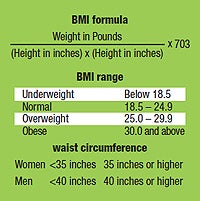Obesity & Your BMI
Has your doctor told you or do you believe that you are overweight or obese? If so, a few important indicators can provide a view of where you stand on the health spectrum, including BMI.
Having a healthy body mass index (BMI) is very important because higher BMI values correspond with increased risk for a host of diseases, including type 2 diabetes, heart disease, high blood pressure and cancer. Your WakeMed cardiologists can help you get and keep your BMI under control.
What are BMI and waist circumference?
Body Mass Index (BMI) is one way of measuring body fat. It is based on your height and weight.
Waist circumference is exactly what it sounds like — the measurement of the size of your waist. It can help doctors determine whether you store a significant amount of fat around your waist. And studies have shown that carrying belly fat, rather than at your hips, increases your risk of heart disease and type 2 diabetes.
How are BMI and waist circumference measured?
You can calculate your own BMI fairly easily, provided you have both an accurate weight and height. You can do the math yourself using the equation on this page. Once you have calculated your BMI, you can use that number to figure out where you fall on the scale of underweight, normal weight, overweight or obese.
While this measurement is accurate for most people, keep in mind that it can be inaccurate for certain populations, including muscular athletes and older individuals or others who may have lost muscle mass.
To measure your waist circumference, while standing, breathe out and then wrap a tape measure around your middle, slightly above your hipbones. Risks of heart disease and type 2 diabetes increase with a waist size greater than 35 inches for women or 40 inches for men.
What are the risks of high BMI and waist circumference?
It’s no secret that being overweight or obese increases the risk of disease, including type 2 diabetes, heart disease, high blood pressure, breathing problems, gallstones and even cancer. But when a high BMI is combined with a waist circumference of greater than 35 in women or greater than 40 in men, those risks are compounded.

For example, while a person with a BMI in the overweight category is considered at “increased” risk of developing these diseases, that same person is considered at “high” risk if they also have a waist circumference over the recommended measurement.
Significant abdominal belly fat causes metabolic imbalance in the body, leading to insulin resistance, and that causes diabetes, high blood pressure, and all of the diseases related to those conditions. Abdominal fat releases certain chemicals that cause an imbalance in insulin sensitivity. Abdominal obesity can also expose you to the risk of sleep apnea, which is also a life-threatening condition.
How are high BMI or waist circumference treated?
The best treatment is to lose weight especially if you have two or more additional risk factors including high blood pressure, high blood sugar, high LDL or low HDL cholesterol and a family history of heart disease. Fortunately, losing just 5 to 10 percent of your current weight can significantly lower your risk of developing the variety of diseases associated with obesity.
There are two things you can do to reverse obesity. You can eat less and exercise more. Eating less can be easier said than done. Foods that are packed with calories will make you prone to gaining weight, and that’s one of the biggest problems in our society, since many of the foods we eat are packed with calories.
As far as exercise, any kind of exercise – walking, biking, playing sports – all of those things are very important and allow you to burn more calories, helping to balance the calories you take in with the calories you burn and thus reduce abdominal fat.